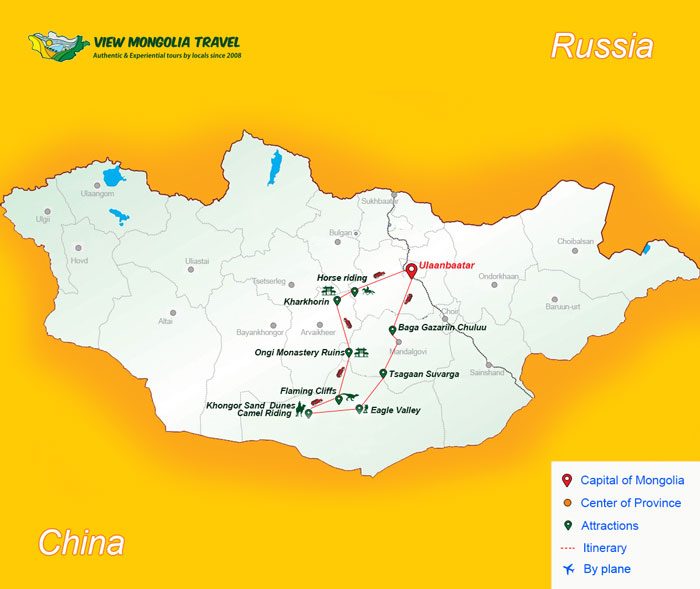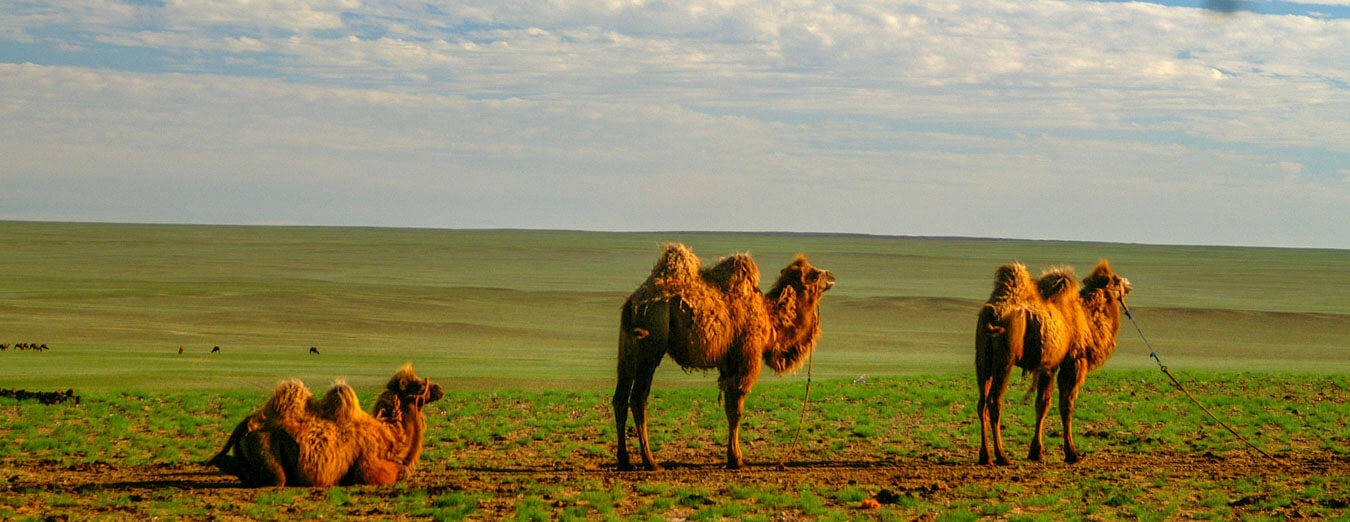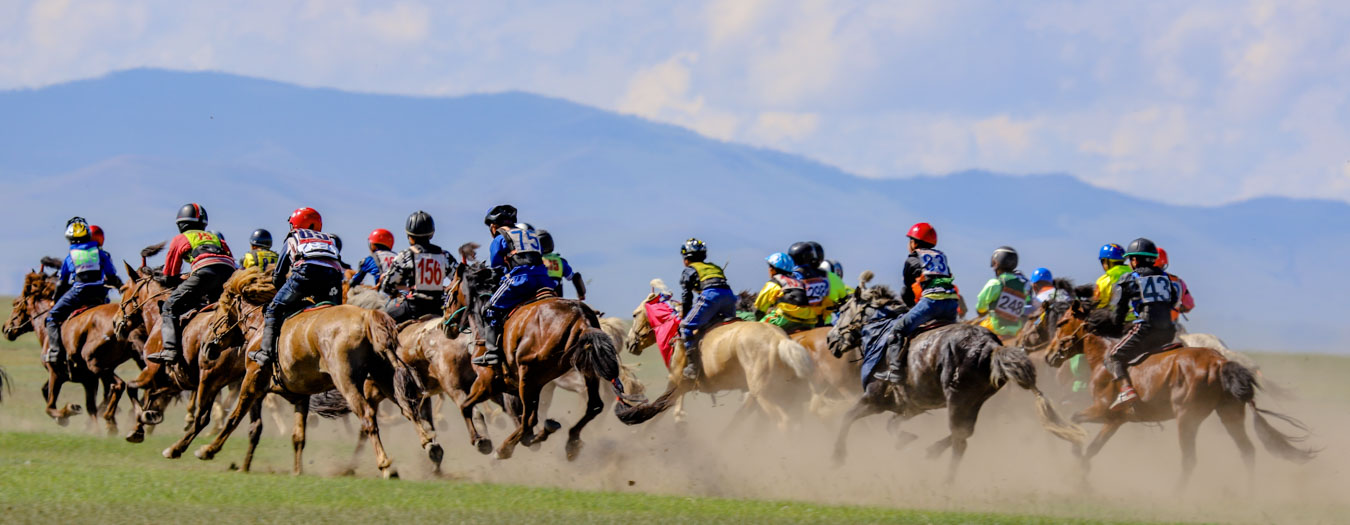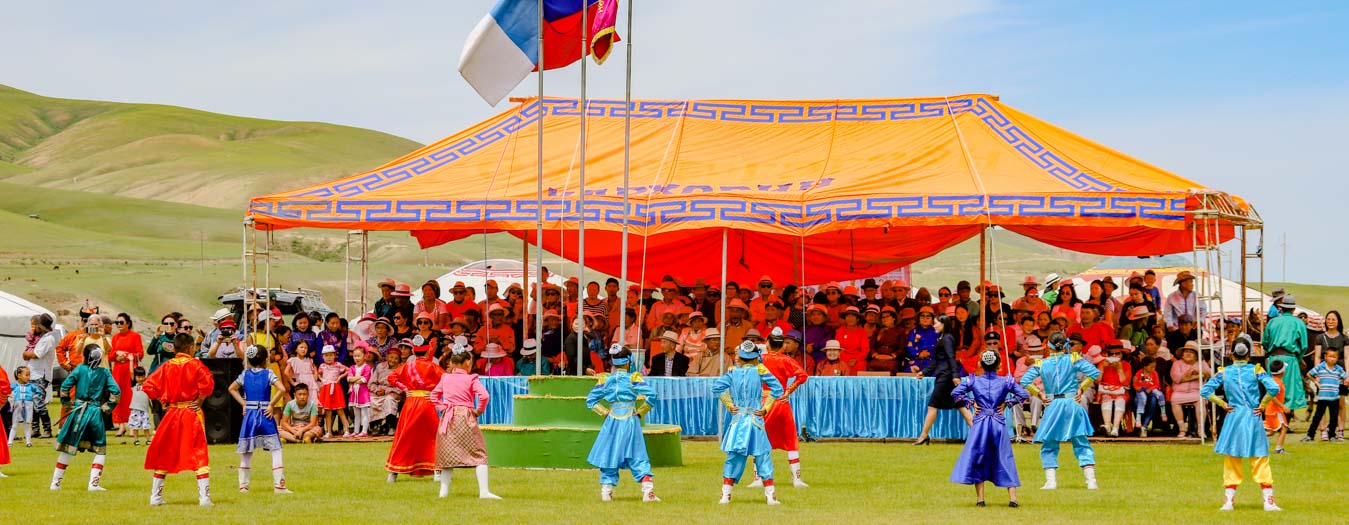Gobi Desert Group Travel Itinerary Overview
The Gobi desert is a unique and surprisingly beautiful area that could be found only in central Asia. Especially, Mongolia contains the Gobi, where the vast open grassy and gravel steppes meet with the horizon of the blue sky, nomads migrate with their animals, endemic and endangered wild animals seen here and there, the sun rises and sets over the steppe. Also, the Gobi desert is an ideal destination for stargazing.
On this well-designed Gobi desert travel, you will sightsee the famous scenic areas, experience the best activities of the Gobi desert, unravel the history and the people’s culture while visiting nomads and having lunch with them, ride horses and camels. Additionally, you explore the famous Orkhon Valley and Erdenezuu Monastery.
Day 1: Travel to Baga Gazariin Chuluu in the Gobi desert
Your guide and driver pick you up from the downtown hotels between 7:30 and 8:30. Start your group tour of the Gobi desert driving on a paved road heading Baga Gazariin Chuluu, a zone of granite stone mountains. Lunch at a ger camp near Baga Gazarin Chuluu.
Baga Gazariin Chulluu Mountain has been keeping some historical remains such as a ruin of a monastery, ancient tombs, etc. Soft hiking among beautiful granite stone mountains tower on the Gobi desert steppe, challenge your imagination seeing unique features of the granite formations, explore a ruin of an old monastery and enjoy the emptiness of the Gobi desert. Your first day in the Gobi and first night in a ger.
Accommodation: Tourist Ger camp
Meals: Lunch, Dinner
Driving distance: 270 km on paved and rough roads – 5 to 5.5 hours
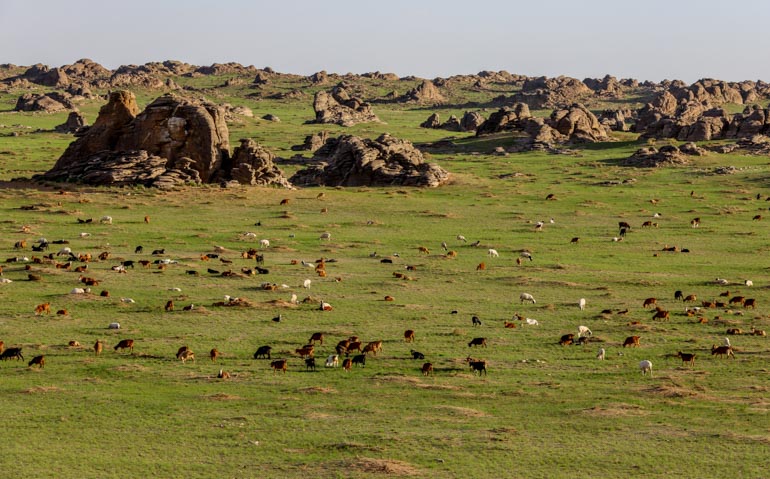
Day 2: Tsagaan Suvarga colorful mud cliffs
Continue the journey to the depths of the Gobi desert. Tsagaan Suvarga is a 30-60 m high, 400 m long, colorful limestone formations that look like stupas.
Lunch at a ger camp near Tsagaa Suvarga and free afternoon to relax and hide from the Gobi desert hot. Late afternoon, we will drive to Tsagaan Suarga and hike along its trails to see the different angles of the beautiful formation.
Accommodation: ger camp
Meals: Breakfast, Lunch, Dinner
Driving distance: 240 km on paved and rough roads – 5 to 5.5 hours
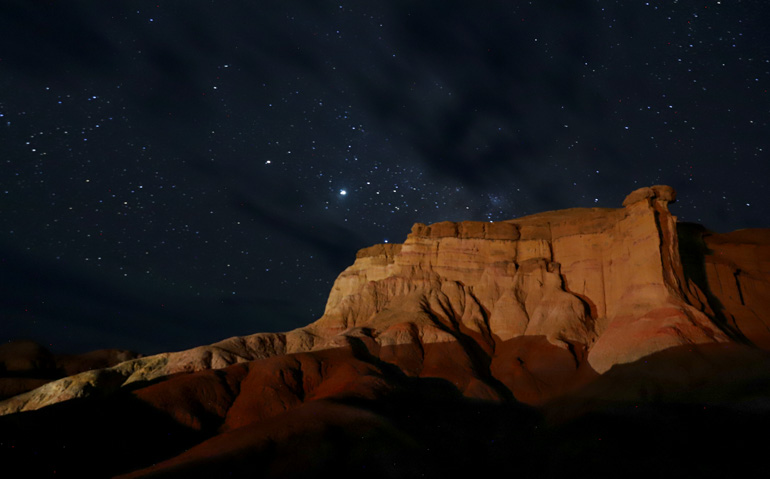
Day 3: Gobi Gurban Saikhan Mountain National Park, hiking in Eagle Valley
After breakfast, we travel to the Gobi Gurban Saikhan Mountain range National Park. It is the end of the Altai Mountains and is amazingly picturesque with lush green valleys, canyons, and crystal clear streams.
You will check-in at a ger camp and have lunch at the ger camp. A short tour to the mountain’s picturesque valley Yoliin Am/Eagle Valley. The valley was named after its main habitat Bearded Eagle or Lammergeier. After reaching the parking area, we gently hike along the mountain creek, which leads the way into the depths of sheer rock canyon that does not accept sunlight. Therefore, it has ice until the end of June. The hiking continues for 2.5 to 3 hours in two ways. Return to the ger camp before dinner and free evening.
Accommodation: Tourist Ger camp
Meals: Breakfast, Lunch, Dinner
Driving distance: 230 km on paved and rough roads – 6 hours
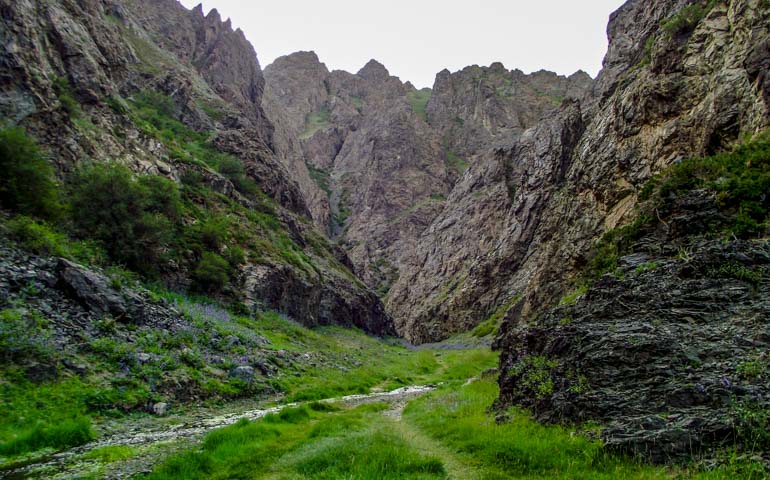
Day 4: Climb Khongor Sand Dunes, visit Gobi desert nomads and camel riding
The journey will continue to Khongor, the largest sand dunes. After reaching the sand dunes, check-in a ger camp and have lunch followed by a visit to a nomad family and an hour of camel riding. Next, climb the sand dune. If you can climb one of the tallest sand dunes, spread the sand northwards against the wind to find the reason why locals call the dunes Singing Sand. The views are fantastic from the top of the sand dunes.
Accommodation: Tourist Ger camp
Meals: Breakfast, Lunch, Dinner
Driving distance: 190 km driving on the rough roads – 4 to 4.5 hours
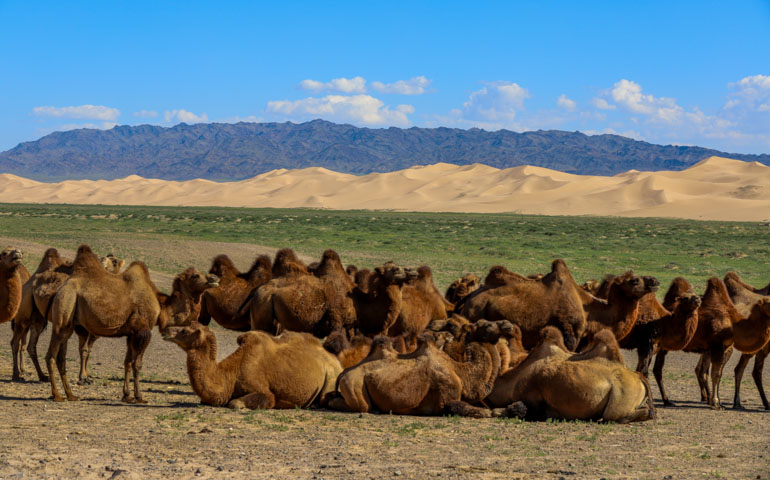
Day 5: Flaming Cliffs – the famous paleontological excavation site
First, we travel to the Khavtsgait Valley in the West Saikhan Mountain of the Gurban Saikhan Mountain National Park to explore some rock drawings dates back to the Late Bronze Age and early Iron Age. Seeing the rock drawing requires us 1 km hiking in a return way. Continue to travel to a ger camp located just 1 km from the Flaming Cliffs. After lunch, enjoy a free afternoon, the 360° views of the steppe, and make your own discovery. We will travel to the Flaming Cliffs late afternoon for good photo moments when the sun goes down. Flaming Cliffs are red sandstone cliffs and canyons, where American explorer Roy Chapman Andrews found the cemetery of dinosaurs and the first dinosaur eggs ever discovered in the world. Thus, Flaming Cliffs are one of the most famous paleontological sites in the world. You will have some hiking through the cliffs in search of dinosaur fossils may found and see the Gobi tree grove named “Bayanzag.” Bayanzag means “rich in saxaul trees.” This tree only grows in Central Asian Gobi.
Accommodation: Tourist Ger camp
Meals: Breakfast, Lunch, Dinner
Driving distance: 170 km driving on the rough roads – 4 to 4.5 hours
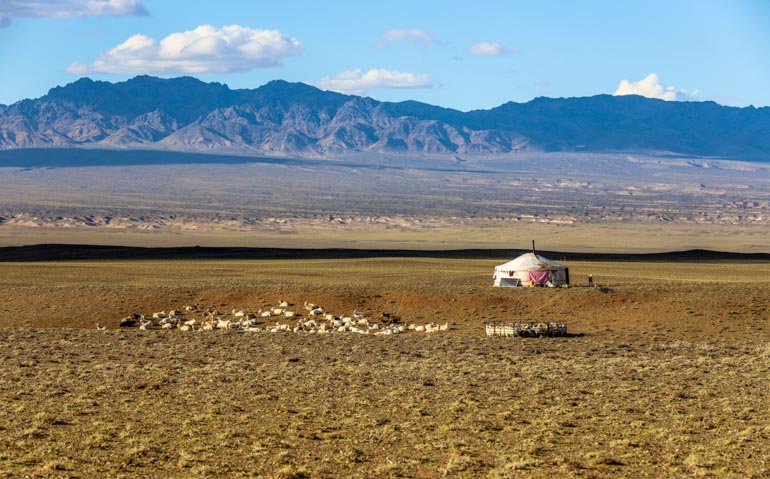
Day 6: Drive to Ongi Monastery on the open steppes
Drive first through slate mountains and next on 80 km Ongi steppes heading Ongi Monastery. Ongi Monastery was one of the biggest seven monasteries in Mongolia. There were two separate monasteries consisted of more than 30 temples on the shores of the Ongi River, surrounded by the Gobi desert mountains. The communists destroyed the monastery in the 1930s purge. Now the ruins of the monasteries involve a vast area. Visit a new active temple, a ger museum, explore the monastery ruins. Climbing a nearby mountain to see views of the surrounding areas is an option.
Accommodation: Tourist Ger camp
Meals: Breakfast, Lunch, Dinner
Driving distance: 160 km driving on the rough roads – 4 to 4.5 hours
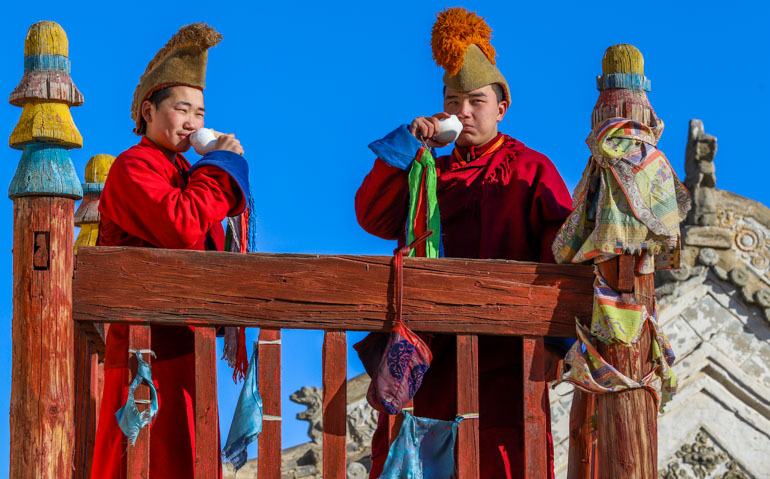
Day 7: Kharkhorin, ancient Monastery Erdenezuu
Today’s tour takes place in the transition zone from the Gobi desert to the mountain steppes. The Kharkhorin and Erdenezuu tour will give us the insight to unravel a history of the Great Mongol Empire, the largest land empire the world has ever had except for exploring the country from the religious side. Kharkhorin and Erdenezuu are part of the World Cultural Heritage Site Orkhon Valley. You will see some valuable religious articles in Erdenezuu temple museums, visit an active temple, observe the religious locals, and view the stunning architecture of the monastery. You also visit the Kharakhorum Museum display remnants of the ancient city except for seeing the historical relics on the site.
Accommodation: Tourist Ger camp
Meals: Breakfast, Lunch, Dinner
Driving distance: 260 km driving on the rough roads – 5.5 to 6 hours

Day 8: Visit central Mongolian nomads, horseback riding, and drive back to Ulaanbaatar
The last day of the full of experiences 8 days of traveling, enjoying the vastness, exploring, and learning the history and culture of Mongolia with like-minded travelers. On your way back to Ulaanbaatar, you will visit a horse herding nomad family. Riding a horse is optional and free of charge. You also join the nomads for lunch. Arrive in Ulaanbaatar and check in a hotel.
Accommodation: Tourist Ger camp
Meals: Breakfast, Lunch, Dinner
Driving distance: 360 km on paved roads takes 6 hours
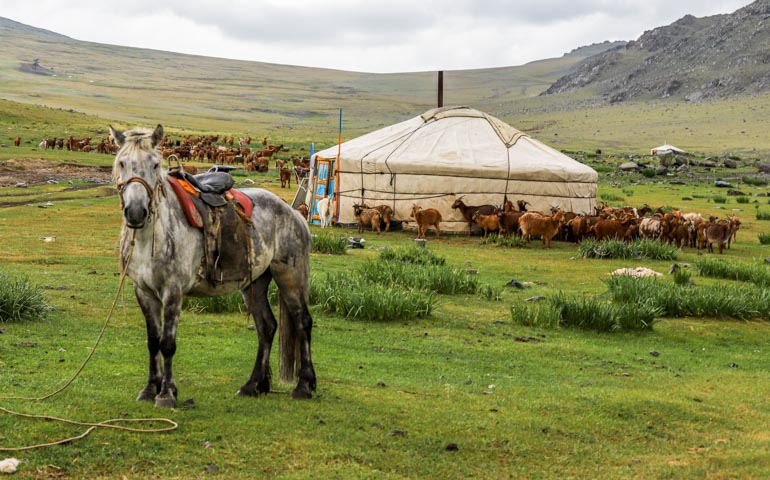
Day 9: Departure
The driver transfers you to the railway station/airport.
Meals: Breakfast
TOUR PRICE PER PERSON
Group tour price: 1100$ per person
Single supplement: 170$
DISCOUNTS
- For children of a family trip
- One free space for every 16 pax (Regards private group tour)
- Early booking discount 10%
- 1 nights in *** hotel
- 7 nights in ger camps
- 24 meals – 8 breakfast, 8 lunch, 8 dinner
- Daily bottled water
- Departure transfer
- English speaking guide
- Entry fees to national parks and museums
- Van transfer
- Horse & camel riding
The tour includes:
- Arrival transfer
- Bar bills, laundry, telephone calls
- International travel
- Items of personal use
- Single supplements
- Travel & medical insurance
- Visa fee
- Gratuity for guides & drivers
The tour excludes:
Is this Gobi Desert group travel suitable for me?
On this tour, you will travel approximately 1900 km driving overland both on the paved and rough roads. The daily driving duration is 4.5-6 hours. Therefore, consider if you have car sickness or back pain, etc.
The tour does not include demanding physical activities except for 1-3 hours of gentle hiking on some days. The group members have an option to climb one of the higher dunes of Khongor, remain at the bottom, or climb lower dunes. Local equestrians will support the horse and camel riding except for your guide. If you are not comfortable with the riding, inform your guide that you will not ride or request a helper to lead your reign.
Accommodation – What is a ger camp in Mongolia?
On this group tour, you will stay in a centrally located 3* hotel for one night on day 8 – at the end of the tour. We always book the best location, best hotel available within the budget for your comfort, safety, and your easy access to city attractions, shopping, dining, etc. If you wish, do not hesitate to request us to book the same hotel at the beginning of your trip. We will check and book for you if the rooms are available on the day of booking.
In the countryside, you will stay in the western friendly traditional ger camps close to the main attractions.
The same as the hotel, we always choose the best ger camps for your enjoyment, comfort, and safety.
You will stay in twin rooms and gers both at the ger camps and hotels unless you request a single supplement and pay additional.
The ger camps have restaurants that serve western and Mongolian cuisines.
Regarding bathrooms, the western WC and showers are in a separate block to share with other travelers. Few of the ger camps have private bathroom gers available at an additional fee of 35$-45$ per person per night.
Some of the ger camps connected with central electricity while the other half sources the electricity from the generator, solar and wind. Learn more about the ger camps and see pictures at What is a ger camp in Mongolia?
What meals will I eat during the Gobi desert group travel?
The tour includes 8 breakfasts, 8 lunches, and 8 dinners. In the countryside, ger camps serve some European and Mongolian meals. Meat is the main recipe for lunch and dinner and is served along with vegetables, salads, and soups. There will be more meat in traditional Mongolian meals.
BREAKFAST: A typical breakfast consists of tea, coffee, bread, jam, butter, eggs, sausage, cookies, cheese, and cereals.
LUNCH: They serve some salads, Mongolian soups, main courses (pasta, rice, vegetables, beef/mutton/chicken/fish near lakes/rivers, traditional meal), and dessert with tea.
DINNER: Salad, a main course, dessert, and tea will be served.
Are you a vegetarian or have a dietary restriction? If you are a vegetarian or have dietary restrictions, please inform us in advance. We will arrange the meals accordingly.
Water; Bottled water is provided daily.
Meals with the nomads: On Day 8, you will try authentic Mongolian lunch with the nomads.
Guides
An English speaking guide will serve the group. They are all friendly, helpful and most of them were born and raised in the Mongolian countryside. Therefore, they have good knowledge about every aspect of Mongolia and have at least three years or more years of guiding experience. During the camel riding, a local guide will support you
What is transportation for the Gobi desert group travel
Full-time Japanese van Toyota Hiace is the main vehicles serve for the group tour. Depending on the group size, Mitsubishi Delica and 4WD Hyundai Starex may serve.
When is the best time to travel to the Gobi desert?
The best time to travel to the Gobi desert is between 15 May and 1 October. Therefore, the group tours are available between the above period.
We recommend May, the beginning of June, September, and the beginning of October for travelers who prefer cooler weather and less crowd. Expect daytime weather between +8°C to +25°C and night weather 0°C to +20°C. Snowfall may occur in May and September.
The beginning of August and July is the hottest and wettest. As well as busiest due to the traditional holiday Naadam festival. Expect +22°C to +38°C daytime and +16 to +25°C at nights.
The second half of June and August is a perfect time to travel the Gobi desert in terms of weather. Not too hot, not cool, and not rainy. Expect +14°C to +30°C daytime and +8°C to +15°C at nights.
What to bring and wear?
As Mongolian weather is inflexible and fluctuates a lot, not regarding the month, we suggest you pack according to below.
• Torch/headlamp will be useful when going to bathrooms in the evenings and at nights while staying at the ger camps.
• Windproof/waterproof, lightweight jacket at the end of June, July, and in the first half of August and windproof/waterproof warmer jacket in May, in the first half of June, in the last half of August, September, and October.
• Lightweight travel trousers that can be unzipped into shorts would be ideal for most summer days.
• T-shirts and long-sleeved t-shirts will be comfortable and help you to protect your arms from the sun and stay warm on cool days.
• Woolen hat, gloves, and scarf are handy if you are traveling at the beginning of May, September, and the beginning of October.
• Sturdy pair of walking sandals and boots will be useful when you hike in the Eagle Valley and through Tsagaan Suvarga cliffs. If not the hiking shoes, bring sneakers and sandals. Some of the ger camps do not have slippers in their gers.
• Pajamas/tights or something similar that let you stay warm at night.
• Shorts and whatever suitable hot weather up to +38°C during daytime in summer months and +8 to + 18°C in the evening/night temperature. The temperature drops dramatically when it rains.
• Bringing your eyeglasses is preferable instead of lenses on dusty roads.
• Sun cream, lip balm, sunglasses, and a sunhat are vital.
• Bring some pills of common symptoms such as travel sickness pills, allergies pills (there is a vast expanse of grasslands), Pepto-Bismol for the inevitable upset stomach, Antibiotic cream for cuts, scratches, and insect bites, etc. The pills should be carried in the original, clearly labeled container, in your handbag, and should be checked with the Mongolian Embassy if necessary.
• A watch or alarm clock can be useful if your mobile phone does not have enough charge or you do not want to use your phone.
• Both backpacks and suitcases work. The bell boys and service staff of ger camps will help you carry your luggage between the gers and parking areas.
• Razorblades, shampoo, lotions, deodorant, and toothpaste are all available extensively in Ulaanbaatar. However, they are not available at ger camps. Therefore, bring your supply or buy in Ulaanbaatar.
• The ger camps provide big and small towels. Bringing dry/wet tissues, and hand sanitizer will not go wrong. Particularly, during some important stops in the countryside (call of nature).
•Travel and medical insurance, passport, and what else you need.· Camera with a spare battery or with a mobile charger. Make sure your power bank and batteries meet the your flight operator requirements because it sometimes causes a delay in your luggage on some international flights.
• Resealing (Ziploc) plastic bags – to protect your documents, money, camera, binoculars, and other items from wetness, sand, and dust.
• Check here vaccinations and health information needed to travel Mongolia.
• Small gifts for nomad children if you do not mind. Visiting nomads and learning about this unique culture is an inseparable and experiential part of our tours. Expressing thanks for your sudden and uninformed visits to nomads on your way and their hospitality is nice feeling either of you. Giving little gifts to the nomads is not a must, but you may like to give little more happiness to the people live in the middle of nowhere. Below are just to give you an idea: Any of small toys, hair ribbons, children’s books, educational materials, paper, pencils, crayons or sweets for children, sewing kits, face or hand cream, a little perfume, cigarettes, cigar-related items or snuff tobacco for adults. Candies are an ideal gift for both children and adults to keep things simple.

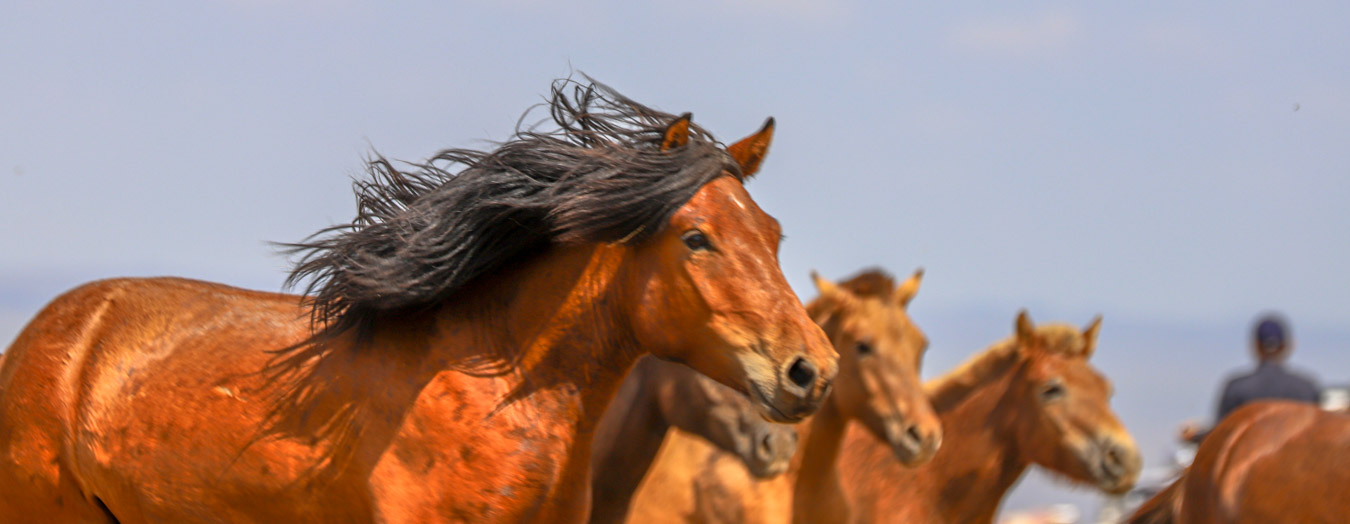 Feel Mongolia Group Horse Riding Tour
Feel Mongolia Group Horse Riding Tour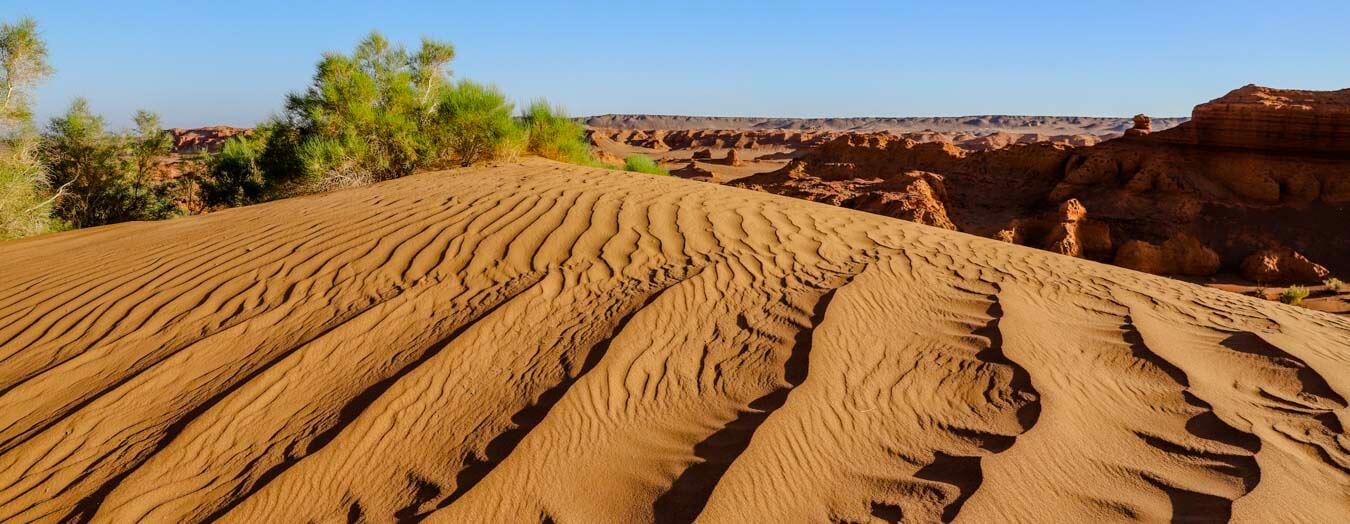 Gobi Desert and Central Mongolia Group Tour Package
Gobi Desert and Central Mongolia Group Tour Package Discover the Gobi Desert Group Travel
Discover the Gobi Desert Group Travel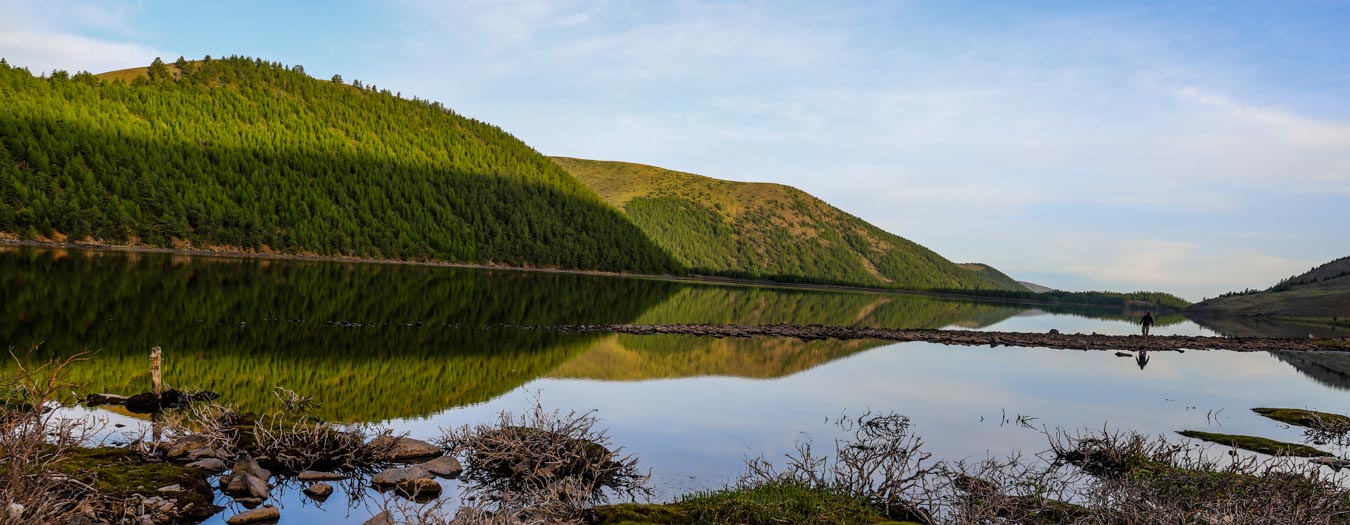 Explore Mongolia Group Tour
Explore Mongolia Group Tour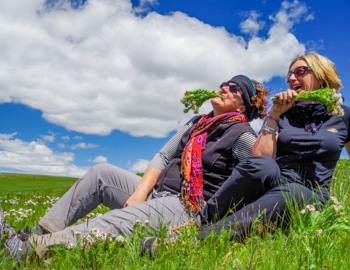 Why View Mongolia Group Tour Operator?
Why View Mongolia Group Tour Operator?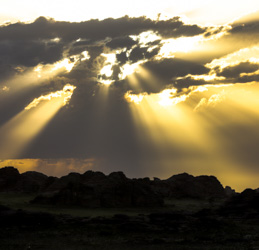 Mongolia Monthly Weather
Mongolia Monthly Weather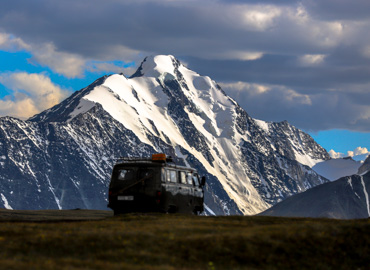 Mongolia Group Tour Terms & Conditions
Mongolia Group Tour Terms & Conditions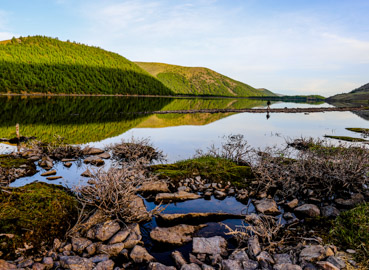 FAQ Before Travel Mongolia
FAQ Before Travel Mongolia